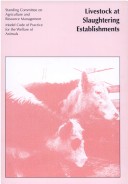SCARM REPORT
4 total works
This Code of Practice is intended as a standard for those involved in slaughtering livestock. It covers aspects of unloading, pre-slaughter handling and the slaughter process and aims to encourage the efficient, considerate treatment of animals so that stress is minimised. It includes a section about emergency slaughter of sick, crippled and 'downer' animals. Techniques for the humane destruction of animals are also described in the Code.
This Code of Practice for the Welfare of Animals serves as a guide for those responsible for the welfare of pigs under intensive and extensive systems. It recognizes that the basic requirement for the welfare of pigs is a husbandry system appropriate to their physiological and behavioural needs.
These Model Codes of Practice are intended as a guide for people responsible for the welfare and husbandry of a range of animals. The Codes are kept under review to take account of advances in the understanding of animal physiology and behavioural technology, changes in animal husbandry and their relationships to the welfare of animals.
Australian Standard for Hygienic Production of Game Meat for Human Consumption
by CSIRO PUBLISHING
Published 1 January 1997
This Standard applies to the production for human consumption of products derived from wild animals and birds killed in their natural environment. It contains the minimum requirements of hygiene in harvesting, transport, processing, packaging and storage, to assure a safe product. Provision is made for small animals such as hare and game birds presented whole. The Standard does not apply to production of products from animals or birds unable to roam free, herded or kept under supervision, nor to processing game animals into processed meat products. It does not apply to birds presented for sale eviscerated and without feathers. Generally, it does not apply to "captured game" which can have detailed antemortem inspection prior to slaughter. However, possum presented live are included within this Standard.

